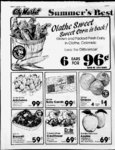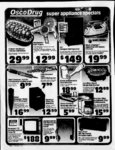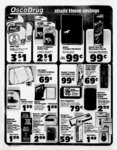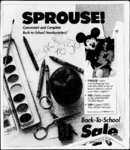| OCR Text |
Show 4 Carbon-Ern- e ry C I a ss tied s Tuesday, August J5, 1989 i , Everything you ever wanted to know about mumps , and more Following the introduction of the live mumps virus vaccine in 1967 and recommendation of its routine use in 1977, the incidence rate of reported mumps cases decreased steadily in the United States. In 1985, a record low of 2,982 cases was reported, representing a 98 percent decline from the 185,691 cases reported in 1967. However, between 1985 and 1987, resurgence a relative of mumps occurred, with 7,790 cases reported in 1986 and 12,848 cases in 1987. During this period, the annual reported incidence rate rose almost fivefold, from 1.1 cases per 100,000 population to 5.2 cases per 100,000 population. In 1988, a provisional total of 4,730 cases was reported, representing a 62 percent ar decrease from 1987. As in the era, the majority of reported mumps cases still occur in pre-vacci- ne children school-age- d (5-1- 4 years of age). Almost 60 per- cent of reported cases occurred in this population betweeen 1985 and 1987, compared with an average of 75 percent of reported cases between 1967 and 1971, the first period postar licensure. However, for the first time since mumps became a reportable disease, the reported peak incidence rate shifted from to older age for two consecutive groups and (1986 1987). Peryears sons 15 years of age accounted for more than one third of the reported total between 1985 and 1987; in 1967-197an 1, average of only 8 percent of reported cases occurred among this population. Although reported mumps incidence increased in all age groups from 1985 to 1987, the most dramatic increases were particular value for children approaching puberty and for adolescents and adults who have not had mumps. Measles mumps rub ell a -- -- among (MMR) vaccine is the vaccine of choice for routine administration and should be used recent outbreaks in high in all situations where recipients are also likely to be susceptible to measles andor rubella. The favorable benefit-cos- t ratio for routine mumps immunization is more marked when vaccine is administered as MMR. Persons should be (almost a sevenfold increase) and (more than an eightfold increase). The increased occurrence of mumps in susceptible adolescents and young adults has been demonstrated in several schools and on college cam- puses and in occupational settings. Vaccine usage Susceptible children, adolescents and adults should be vaccinated against mumps, unless vaccination is contraindicated. Mumps vaccine is of considered susceptible to mumps unless they have documentation of 1) mumps, physician-diagnose- d 2) adequate immunization with live mumps virus vaccine on or after their first birthday, or 3) laboratory evidence of immunity. Because live Volunteers sought for Alzheimers drug study People suffering from mild to moderate symptoms of Alzheimers disease are being sought to participate in a new drug study at the J.L. Sorenson School of Medicine at the University of Utah. The study will involve the experimental drug milacemide to test its effect on memory. Earlier research has 14-we- shown the drug to be somewhat beneficial in animals. Volunteers for the study should be at least 50 years old; healthy, other than the memory failure; and must not be taking other medications. Potential candidates also need to have a responsible caregiver to accompany them on clinical visits and monitor their performance during the course of the study. Human Development and Internal Medicine and medicine. The study will be conducted through the Division of Aging in the departments of Pediatrics at the medical school. The U of U is one of sev- eral centers in the United Know what your insurance covers when you travel Millions ofAmericans vacation in Canada and Mexico ters who represent the States conducting research on the drug. Principal investigator for the study is James S. Wood, M.D., assistant professor of internal medicine, Mexi- m Non-Reside- Utah crop prospects are down this year Non-irrigat- 759-289- 2. non-profi- t, Alzheimers disease is a degenerative brain disease that usually affects people in middle and old age. The prevalence of the disease is expected to increase as America grays and more people enter that age range. The medical community has yet to discover what triggers the illness or find a cure or prevention for the disease. can insurance company, in arrangements with your Mexcase youre involved in an ican insurance company, the make and many every year, accident. RV. While car or a the trip by repaired vehicle can be delivered to the U.S. border. reliable Mexican Several seem to Canada can trip For insurance purposes a insurance companies have almost routine, if youre prophome the recreational United vehicle is defined in insured in representatives erly your state, a trip to Mexico is a tot- States. The most important as a vehicle with sleeping coverages needed in Mexico facilities that can be used for ally different ball game. are property damage liability cooking and eating, and excluWestern Insurance Information Service (WHS) cau($10,000) and bodily injury sively pleasure driving, usualfor tions vacationers heading liability ($10,000 per person ly less than 7,500 miles with a maximum of $20,000 annually. Mexico that you must buy spefor each accident). The same factors used in cial Mexican auto insurance In case of an accident, get in setting auto insurance rates BEFORE leaving the U.S. If touch with your companys are applied to RV policies. you dont, and have an accident, you could end up in jail. closest adjuster and do not Driving records, how the vehicle is used, miles driven and Several U.S. companies do make any arrangements yourself. If your accident caused where the vehicle is garaged have coverage that extends are all valid factors in measurdamage to someones properwithin limited areas of Mexcivil liability is covand the financial risk. ty, ing ico. (Read your policy under will arrange A camper or motor home is the ered, adjuster The territorial limits.) probto settle the claim under the insured as a single vehicle, but lem is that the Mexican government does not recognize conditions of your policy. If a trailer must be insured with is involved, he a car. If a trailer is parked at bodily foreign coverage. Which will injury for medical the campsite and sightseeing arrange means that no U.S. adjuster or done by car only, it is possiis attention. insurance company represenWhen an accident causes ble to eliminate all but fire and tative may conduct business severe property damage or theft coverage on the trailer. in Mexico. So if you are In case of theft, most Mexithe authorities bodily injury, insured only under a U.S. polican detain policies cover only the totmight temporarily cy, you will have to file a claim. This is of the car. Partial theft a al as witness. theft everyone And that could be difficult if not formal the a arrest until radios and accesso(hub caps, you have been detained and blame. If ries) is not covered. But if the investigation proves have no one to represent you. bodily injury is involved, the car is stolen and found guilty party might be detained stripped, the company will Agents of Mexican compaand charged. If your policy replace all of the standard all almost found in nies are American cities on or near the covers third party civil liabiliaccessories of the car. This border. These agents sell a ty, the adjuster will protect does not include purses, short-teryour interests even though the cameras, luggage or any other Special Automobile Policy for Tourists, which policy does not cover bails or personal property in the car. fines. will provide the proper protecIf youre heading for CanaIf your vehicle is wrecked, da, youll need evidence of tion. Costs of the policies vary, depending on the tjme spent the repairs are going to take a financial responsibility. Most in Mexico, the value of the car, long time, and you have to American motorists satisfy and the amount of coverage return home, you must this requirement by obtaining purchased. arrange for a government per- a Canada e Make sure that you get a mit to leave the country withMotor Vehicle of RV. out and the auto or adjusagents your Through Liability Insurance Card listing from their insurance agent, broker or company representative. Youll need the card if youre involved in an accident. The card shows that your insurance company is willling to meet minimum financial responsibility requirements Utah crop prospects for 2 percent from 1988. Dry in Canada. And, it eliminates winter wheat, spring wheat, beans at 2.3 million pounds, the possibility that your car may be impounded or your are down 12 percent. Oat procom for grain, barley, dry edible beans and alfalfa hay are duction, at 1.3 million driving privileges suspended down for the second year, bushels, is up 29 percent from in case of an accident. If you would like further 1988. Alfalfa hay, at 1.81 milaccording to the Utah Agricuon auto insurinformation lion tons is down 3 percent. ltural Statistics Service. renance, crop acreage Other hay at 221,000 tons is ters taking inventory, insurance and more, has suffered from unusually expected to be down 17 contact: Western please hot and dry weather. percent. Insurance Information SerUtah winter wheat producvice (WIIS), 6000 East Evans, tion is forecast at 5 bushels, Nationally, winter wheat at Bldg. 3, Suite 337, Denver, down 11 percent from 1988. 1.47 billion bushels, is down 6 Colorado (303) 80222, Average yield, at 32 bushels percent from last year. Spring per acre is down 4 bushels. wheat production is up 137 WIIS is a nonSpring wheat production at percent, and barley 35 per- lobbying consumer education 1.2 million bushels, is down 3 cent. Com production at 7.35 and communications organipercent. Barley is expected to billion bushels, is up 49 per- zation, affiliated with the be 9.3 million bushels, down 4 cent, and dry beans 29 per- Insurance Information Insticent. Oat production is up 74 percent from the previous tute, serving consumers and year. Com grain is estimated percent, alfalfa 12 percent and and insurers in ten western to be 2.7 million bushels, down other hay 17 percent. states. Inter-Provinc- whose specialty is geriatric nt Current management for Alzheimers entails helping people preserve their memory functions as long as possible. The diseases symptoms often include forgetting words or names, misplacing valuable possessions or getting lost easily. People with Alzheimers often deny the problem with failing memory, although it is usually obvious to friends and family members. For further information on the study, call Haley Nicastro at the University of Utah Health Sciences Center, 581-262- 8. Tax mumps vaccine was not used routinely before 1977 and because the peak incidence was in before the vaccine was introduced, most persons born before 1957 are likely to have age-specif- ic been infected naturally between 1957 and 1977. Therefore, they generally may be considered to be immune, even it they may not have had clinically recognizable mumps disease. However, this cutoff date for susceptibility is arbitrary. Although outbreak-contro- l efforts should be focused on persons bom after 1956, these recommendations do not preclude vaccination of possibly susceptible persons bom before 1957 who may be exposed in outbreak settings. Persons who are unsure of their mumps disease history andor mumps vaccination history should be vaccinated. There is no evidence that persons who have previously either received mumps vaccine or had mumps are at any increased risk of local or systemic reactions from receiving live mumps vaccine. Testing for susceptibility before vaccination, especially among adolescents and young adults, is not necessary. In addition to the expense, some tests (e.g., mumps skin test and the complement-fixatio- n antibody test) may be unreliable, and tests with established reliability (neutralization, enzyme immunoassay, and radial hemolysis antibody tests) are not readily available. Dosage in the volume specified by the A single dose of vaccine manufacturer should be adm- inistered subcutaneously. While not recommended routinely, intramuscular vaccination is effective and safe. Age Live mumps virus vaccine is recommended at any age on or after the first birthday for all susceptible persons, unless a contraindication exists. Under routine circumstances, mumps vaccine should be given in combination with measles and rubella vaccines as MMR, at 15 months of age. It should not be administered to infants 12 months old because persisting maternal antibody might interfere with seroconversion. To insure immunity, all persons vaccinated before the first brithday should be revaccinated on or after the first birthday. Persons exposed When given after exposure to mumps, live mumps virus vaccine may not provide protection. However, if the exposure did not result in infection, vaccine should induce protection against infection from subsequent exposures. There is no evidence that the d risk of adverse events increases if vaccine is administered to persons incubating disease. Immune globulin (IG) has not been demonstrated to be of established value in postexposure prophylaxis and is not vaccine-associate- recommended. Adverse effects of vaccine use In field trials before licen- sure, illnesses did not occur more often in vaccinees than in unvaccinated controls. Reports of illnesses following mumps vaccination have mainly been episodes of paroe fever. titis and Allergic reactions including rash, pruritus, and purpura have been temporarily associated with mumps vaccination but are uncommon and usually mild and of brief duration. The reported occurrence of encephalitis within 30 days of receipt of a mumps-containin- g vaccine (0.4 per million doses) is not greater than the observed background low-grad- rate of CNS incidence dys- function in the normal population. Other manifestations of CNS involvement, such as febrile seizures and deafness, have also been infrequently reported. Complete recovery is usual. Reports of nervous system illness following mumps vaccination do not necessarily denote an etiologic relationship between the illness and the vaccine, Single copies of the recently revised recommendations for mumps prevention are available from the Bureau of Epidemiology Source: of Health. (538-6191- ). Utah Department change affects child care A new tax law change will generally require taxpayers claiming the child and dependent care credit to provide the name, address and taxpayers identification number (TIN) of the dependent care provider with their federal tax returns, according to the Internal Revenue Service. The new requirement Jan. 1, 1989 and will affect 1989 tax returns filed in 1990. Failure to comply may result in the disallowance of the credit becomes effective which could otherwise provide taxpayers with as much as $720 to $1440 in tax savings. To help taxpayers comply, the law also requires dependent care providers to furnish their customers the necessary information. Taxpayers may use Form W-1Dependent Care Providers identification and Certification to get this information. Form 0 should be kept with' the taxpayers records in case it is necessary to establish, to the IRS upon request, that he or she exercised due diligence in obtaining this information. It is not to be filed with the federal income tax return. However, taxpayers must include the information on name, address and TIN Form 2441 if they file Form 1040 or Schedule 1 if they file Form 1040 A. If the dependent care provider is an organization exempt from federal income tax and is the type described in section 501(c)(3), the provider is not required to supply its TIN to the taxpayer. In such cases, the organization completes the name and address portion of Form 0 in the and writes space for the TIN. If Form 0 is not used, taxpayers can obtain a copy of 0, W-1- W-1- tax-exem- W-1- pt the providers Social Security card or drivers license (in a state where the license includes the Social Security number). Taxpayers may also try to obtain a recently printed letter or printed invoice of the provider showing the required information. In cases where the taxpayers employer is the provider, a copy of the statement furnished by the employer under a dependent care assistance program, showing the employers name, address and TIN, may be obtained. If the provider is a household employee and has given the taxpayer a properly completed Form W-- 4 to have income tax withheld, a copy of that Form W-- 4 will suffice. Failure by the dependent care providers (other than organizations) to furnish their correct TINs to the taxpayers can result in a $50 penalty, unless the failure is due to reasonable cause and not to willful neglect. Another provision of the new law requires that beginning in 1989, the child being cared for must be under the age of 13 rather than age 15 as in 1988. More information on the new requirements can be found in IRS Publication 503, Child and Dependent Care Credit. This publication and Form 0 can be ordered by calling tax-exem- pt W-1- Legislature matches funds for OHV program The Utah state Legislature has created a matching grant fund for the state vehicle program. Funding comes from the gasoline tax and off-highw- vehicle registration fees. A portion of this money has been set aside for the construction, improvement, operation or maintenance of federal, municipal or county-owne- tered d or adminis- vehicle facilities. OHV funds are off-highw- matched with like funding from other agencies. The program is administered by the Division of Parks and Recreation. For the 1988-8- 9 fiscal year, the Forest Service received $42,500 for OHV development on Forest Service managed lands; the Bureau of Land Management received Some OHV Forest Service projects include the $32,250. Fish LakePiute OHV Trail (300 miles), the DixieEast Fork OHV Trail (60 miles adjacent to Bryce Canyon), and the Chalk Creek OHV Trail (33 mile loop trail). Among the BLM projects are the Payson Canyon OHV track, Little Sahara Dunes, the Knolls OHV area and the Temple Mountain OHV area. All projects are scheduled for completion by the end of the calendar year. Any land managing agency may apply for the grants. Eligible agencies include any federal agency or political subdivision of the state. Grant applications are due on Aug. 31 for the 1989-9- 0 fiscal year. Applications are available at the Utah State Parks office, 1636 W. North Temple, Salt Lake City, UT 84116. For further information contact Scott Behunin, 538-734- 2. |










































































